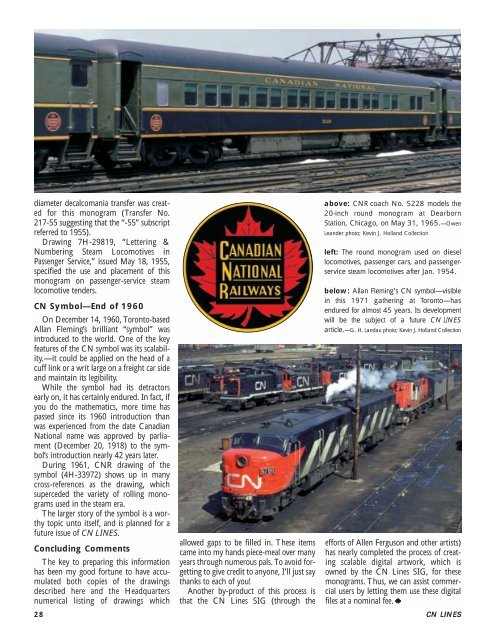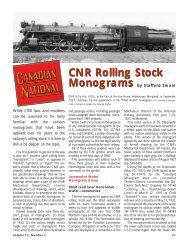CN LINES V12N3 - Canadian National Railways Historical Association
CN LINES V12N3 - Canadian National Railways Historical Association
CN LINES V12N3 - Canadian National Railways Historical Association
You also want an ePaper? Increase the reach of your titles
YUMPU automatically turns print PDFs into web optimized ePapers that Google loves.
diameter decalcomania transfer was created<br />
for this monogram (Transfer No.<br />
217-55 suggesting that the “-55” subscript<br />
referred to 1955).<br />
Drawing 7H-29819, “Lettering &<br />
Numbering Steam Locomotives in<br />
Passenger Service,” issued May 18, 1955,<br />
specified the use and placement of this<br />
monogram on passenger-service steam<br />
locomotive tenders.<br />
<strong>CN</strong> Symbol—End of 1960<br />
On December 14, 1960, Toronto-based<br />
Allan Fleming’s brilliant “symbol” was<br />
introduced to the world. One of the key<br />
features of the <strong>CN</strong> symbol was its scalability.—it<br />
could be applied on the head of a<br />
cuff link or a writ large on a freight car side<br />
and maintain its legibility.<br />
While the symbol had its detractors<br />
early on, it has certainly endured. In fact, if<br />
you do the mathematics, more time has<br />
passed since its 1960 introduction than<br />
was experienced from the date <strong>Canadian</strong><br />
<strong>National</strong> name was approved by parliament<br />
(December 20, 1918) to the symbol’s<br />
introduction nearly 42 years later.<br />
During 1961, <strong>CN</strong>R drawing of the<br />
symbol (4H-33972) shows up in many<br />
cross-references as the drawing, which<br />
superceded the variety of rolling monograms<br />
used in the steam era.<br />
The larger story of the symbol is a worthy<br />
topic unto itself, and is planned for a<br />
future issue of <strong>CN</strong> <strong>LINES</strong>.<br />
Concluding Comments<br />
The key to preparing this information<br />
has been my good fortune to have accumulated<br />
both copies of the drawings<br />
described here and the Headquarters<br />
numerical listing of drawings which<br />
allowed gaps to be filled in. These items<br />
came into my hands piece-meal over many<br />
years through numerous pals. To avoid forgetting<br />
to give credit to anyone, I’ll just say<br />
thanks to each of you!<br />
Another by-product of this process is<br />
that the <strong>CN</strong> Lines SIG (through the<br />
above: <strong>CN</strong>R coach No. 5228 models the<br />
20-inch round monogram at Dearborn<br />
Station, Chicago, on May 31, 1965.—Owen<br />
Leander photo; Kevin J. Holland Collection<br />
left: The round monogram used on diesel<br />
locomotives, passenger cars, and passengerservice<br />
steam locomotives after Jan. 1954.<br />
below: Allan Fleming’s <strong>CN</strong> symbol—visible<br />
in this 1971 gathering at Toronto—has<br />
endured for almost 45 years. Its development<br />
will be the subject of a future <strong>CN</strong> <strong>LINES</strong><br />
article.—G. H. Landau photo; Kevin J. Holland Collection<br />
efforts of Allen Ferguson and other artists)<br />
has nearly completed the process of creating<br />
scalable digital artwork, which is<br />
owned by the <strong>CN</strong> Lines SIG, for these<br />
monograms. Thus, we can assist commercial<br />
users by letting them use these digital<br />
files at a nominal fee.<br />
28 <strong>CN</strong> <strong>LINES</strong>



